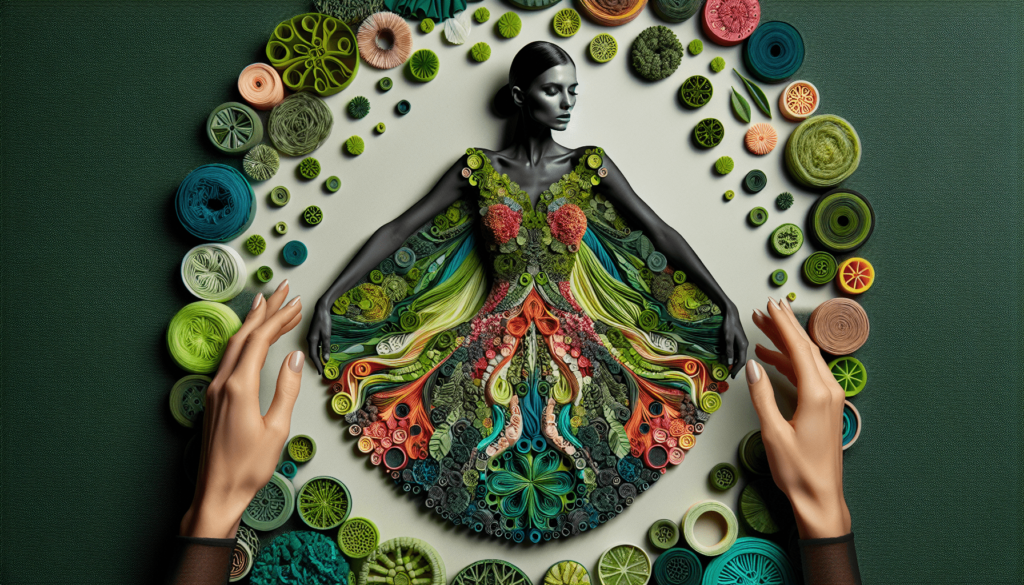Welcome to the exciting world of Eco-Friendly Fashion, where sustainability meets style in a holistic approach to clothing and accessories. In this article, you will explore the importance of eco-friendly practices in the fashion industry, learn about sustainable materials and production methods, and discover how you can make more conscious choices as a consumer. Get ready to revolutionize your wardrobe and make a positive impact on the planet with Eco-Friendly Fashion: A Holistic Approach. Have you ever wondered how you can make a positive impact on the environment through your fashion choices? Today, we will explore the world of eco-friendly fashion and how you can take a holistic approach towards creating a sustainable wardrobe you can feel good about. Let’s dive in!

The Basics of Eco-Friendly Fashion
When it comes to eco-friendly fashion, the key is to make conscious choices that minimize harm to the environment and promote sustainability. From the materials used to the manufacturing processes and end-of-life disposal, every aspect of a garment’s lifecycle can have an impact on the planet. By opting for eco-friendly fashion, you can reduce your carbon footprint and contribute to a healthier planet for future generations.
Choosing Sustainable Materials
One of the most important aspects of eco-friendly fashion is the materials used to make your clothing. Traditional fabrics like cotton and polyester have a significant impact on the environment due to the heavy use of water, pesticides, and chemicals in their production. Instead, opt for sustainable materials like organic cotton, bamboo, hemp, Tencel, or recycled fabrics. These materials are grown and produced in a way that minimizes harm to the environment and often have a lower carbon footprint.
Supporting Ethical Production
In addition to choosing sustainable materials, it’s crucial to support brands that prioritize ethical production practices. Look for companies that pay fair wages, provide safe working conditions, and source materials responsibly. By supporting ethical fashion brands, you can help ensure that the people behind your clothes are treated fairly and that harmful practices are avoided throughout the supply chain.
Minimizing Waste
Another key aspect of eco-friendly fashion is minimizing waste. Fast fashion has led to a “throwaway” culture where clothing is discarded after only a few wears, leading to a significant amount of waste in landfills. To combat this, consider investing in timeless, high-quality pieces that will last for years to come. You can also donate or recycle clothing you no longer wear to give them a new life and reduce the demand for new garments.
Building a Sustainable Wardrobe
Building a sustainable wardrobe doesn’t have to be overwhelming. By taking a holistic approach and making conscious choices, you can create a wardrobe that reflects your values and helps protect the planet. Here are some tips to help you build a sustainable wardrobe that’s both stylish and eco-friendly.
Assess Your Current Wardrobe
Before you start shopping for new clothes, take some time to assess your current wardrobe. Look through your closet and identify the pieces you wear regularly, as well as those that have been sitting untouched for months. Consider whether you really need to purchase new items or if you can mix and match what you already have to create new outfits. By making the most of what you already own, you can reduce the urge to shop for new clothes and minimize your environmental impact.
Invest in Versatile Pieces
When adding new items to your wardrobe, focus on versatile pieces that can be mixed and matched to create a variety of looks. Look for classic styles and timeless designs that will withstand changing trends and can be worn season after season. By investing in quality basics like a well-fitting pair of jeans, a classic blazer, or a versatile dress, you can create a capsule wardrobe that’s both sustainable and stylish.
Embrace Secondhand Shopping
One of the best ways to build a sustainable wardrobe is by embracing secondhand shopping. Thrift stores, consignment shops, and online resale platforms offer a treasure trove of gently used clothing at a fraction of the cost of new items. Not only does shopping secondhand help reduce the demand for new clothes, but it also gives pre-loved items a new lease on life. Plus, you can find unique pieces that no one else will have, making your wardrobe truly one-of-a-kind.
Consider Renting or Swapping
If you’re looking to cut down on waste and save money, consider renting clothing for special occasions or participating in clothing swaps with friends. Renting formalwear, evening gowns, or designer pieces can be a more sustainable option than buying new items that you’ll only wear once. Clothing swaps are also a fun way to refresh your wardrobe without spending a dime. By sharing clothes with friends or attending swap events, you can give new life to pieces you no longer wear and discover new treasures to add to your collection.
What to Look for in Eco-Friendly Fashion Brands
When shopping for eco-friendly fashion, it’s important to look beyond the label and consider the brand’s commitment to sustainability. Not all “green” brands are created equal, so it’s essential to do your research and choose companies that align with your values. Here are some key factors to consider when evaluating eco-friendly fashion brands.
Transparency
Look for brands that are transparent about their production processes, materials used, and ethical practices. Transparency is key to ensuring that the company’s claims of sustainability are legitimate and not just greenwashing. Companies that are open about their supply chain, partnerships, and impact on the environment are more likely to be committed to eco-friendly practices.
Certifications
Certifications from third-party organizations can help verify a brand’s commitment to sustainability and ethical production. Look for certifications like Fair Trade, Global Organic Textile Standard (GOTS), OEKO-TEX Standard 100, and the Better Cotton Initiative (BCI) when shopping for eco-friendly fashion. These certifications indicate that the brand has met specific standards for environmental and social responsibility and can help you make more informed purchasing decisions.
Environmental Impact
Consider the brand’s environmental impact throughout the entire lifecycle of their products, from sourcing materials to manufacturing, transportation, and end-of-life disposal. Look for brands that use eco-friendly materials, minimize waste in production, and offset carbon emissions from shipping. Companies that prioritize sustainability will often have information on their website about their efforts to reduce their environmental footprint and protect the planet.
Social Responsibility
In addition to environmental impact, consider the brand’s commitment to social responsibility and ethical practices. Look for companies that support fair labor practices, provide safe working conditions, and invest in their employees and local communities. Brands that prioritize people as well as the planet are more likely to be dedicated to creating positive change in the fashion industry and beyond.
Making Sustainable Fashion Choices Every Day
Creating a sustainable wardrobe is an ongoing process that requires conscious choices and a commitment to eco-friendly practices. While it may seem daunting at first, even small changes can make a big difference in the long run. Here are some everyday steps you can take to make more sustainable fashion choices and reduce your environmental impact.
Wash Your Clothes Wisely
Did you know that washing and drying your clothes can have a significant impact on the environment? Reduce your carbon footprint by washing your clothes in cold water, line-drying them when possible, and using eco-friendly detergents. Avoid over-washing your clothes and opt for spot-cleaning or air-drying between washes to prolong the life of your garments and save energy.
Care for Your Clothes Properly
Extend the life of your clothing by caring for them properly. Follow the care instructions on the label, mend any tears or loose seams, and store your clothes in a cool, dry place away from direct sunlight. By taking care of your garments and keeping them in good condition, you can reduce the need to replace them frequently and minimize waste.
Recycle and Donate Unwanted Clothing
When it’s time to say goodbye to clothes you no longer wear, consider donating them to charity or recycling them through clothing donation programs. Many organizations accept gently used clothing to help those in need or recycle textiles into new products. By giving your clothes a new life through donation or recycling, you can keep them out of landfills and support a more circular economy.
Educate Yourself and Others
Finally, take the time to educate yourself and others about the importance of sustainable fashion. Share your knowledge with friends and family, support eco-friendly brands, and engage with organizations working to create a more sustainable and ethical fashion industry. By raising awareness and advocating for change, you can help drive positive impact in the fashion world and inspire others to make more sustainable choices.

Conclusion
Eco-friendly fashion is about more than just what you wear – it’s about the impact your choices have on the planet and the people who make your clothes. By taking a holistic approach and considering every aspect of a garment’s lifecycle, you can create a sustainable wardrobe that reflects your values and helps protect the environment. Whether you’re shopping for new clothes, caring for your garments, or supporting ethical brands, every choice you make can make a difference in creating a more sustainable fashion industry. Embrace eco-friendly fashion and take the first step towards a more conscious and compassionate wardrobe that’s good for you and the planet.

